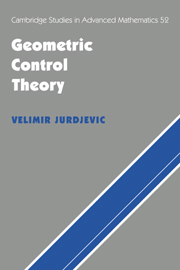Book contents
- Frontmatter
- Contents
- Introduction
- Acknowledgments
- Part one Reachable sets and controllability
- Part two Optimal control theory
- 7 Linear systems with quadratic costs
- 8 The Riccati equation and quadratic systems
- 9 Singular linear quadratic problems
- 10 Time-optimal problems and Fuller's phenomenon
- 11 The maximum principle
- 12 Optimal problems on Lie groups
- 13 Symmetry, integrability, and the Hamilton-Jacobi theory
- 14 Integrable Hamiltonian systems on Lie groups: the elastic problem, its non-Euclidean analogues, and the rolling-sphere problem
- References
- Index
11 - The maximum principle
Published online by Cambridge University Press: 07 October 2009
- Frontmatter
- Contents
- Introduction
- Acknowledgments
- Part one Reachable sets and controllability
- Part two Optimal control theory
- 7 Linear systems with quadratic costs
- 8 The Riccati equation and quadratic systems
- 9 Singular linear quadratic problems
- 10 Time-optimal problems and Fuller's phenomenon
- 11 The maximum principle
- 12 Optimal problems on Lie groups
- 13 Symmetry, integrability, and the Hamilton-Jacobi theory
- 14 Integrable Hamiltonian systems on Lie groups: the elastic problem, its non-Euclidean analogues, and the rolling-sphere problem
- References
- Index
Summary
Our study thus far points to the maximum principle as the fundamental principle of optimality and identifies the symplectic structure and the associated Hamiltonian formalism as the main theoretical ingredients required for its proper understanding. In this chapter we shall take that direction to its natural end and ultimately arrive at a geometric formulation of the maximum principle for optimal problems on arbitrary differentiable manifolds, rather than solely on ℝn as is customarily done in the literature on control theory. The geometric formulation of the maximum principle, essential for effective use of the principle for problems of mechanics and geometry, in a larger context illuminates the contribution of optimal control to the classic theory of Hamiltonian systems. Both of these points will become clearer in the next chapter, which deals with optimal problems on Lie groups.
This chapter begins with an initial formulation of the maximum principle for optimal problems defined on open subsets of ℝn. Rather than seeking the most general conditions under which the principle is valid, we shall follow the original presentation by Pontryagin et al. (1962). This level of generality is sufficient for the applications that follow and is at the same time relatively free of the technicalities that could obscure its geometric content.
The initial formulation is followed by a comparison between the maximum principle and other necessary conditions for optimality that emphasize the distinctions between strong and weak minima: The maximum principle, as an extension of the condition of Weierstrass, corresponds to the strong minimum, whereas the Euler-Lagrange equation corresponds to the weak minimum.
Information
- Type
- Chapter
- Information
- Geometric Control Theory , pp. 332 - 367Publisher: Cambridge University PressPrint publication year: 1996
Accessibility standard: Unknown
Why this information is here
This section outlines the accessibility features of this content - including support for screen readers, full keyboard navigation and high-contrast display options. This may not be relevant for you.Accessibility Information
- 3
- Cited by
